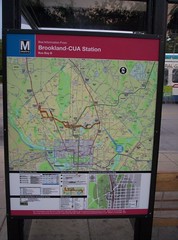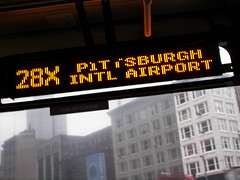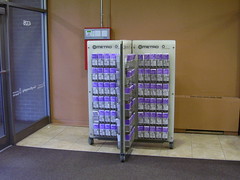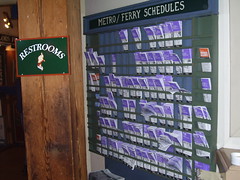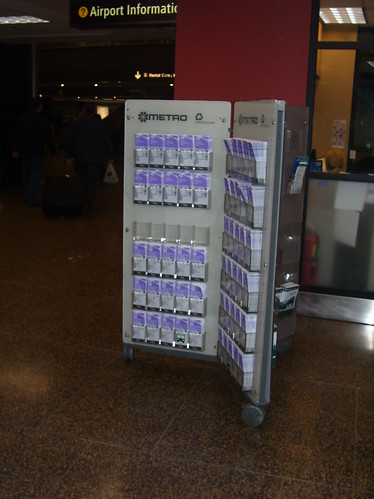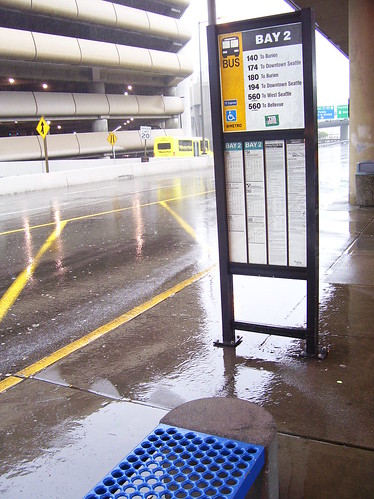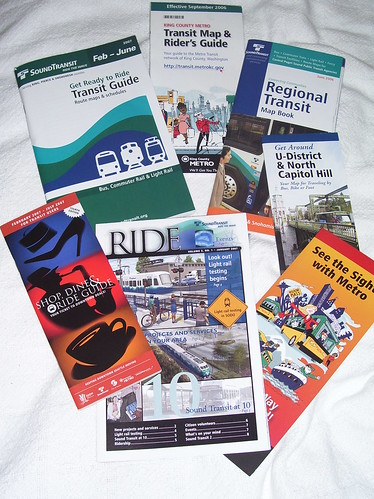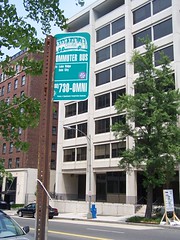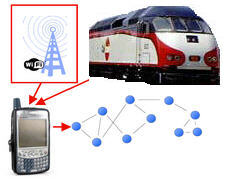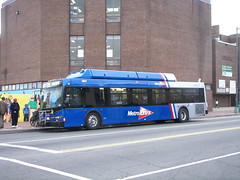 New Metro Extra Bus, Georgia Avenue NW. Photos by Richard Layman.
New Metro Extra Bus, Georgia Avenue NW. Photos by Richard Layman.Hi there... I'm C4bl3Fl4m3 (that's "CableFlame" to those of you that don't read 1337), newest Mad Doctor in the League of Transit Doctors. I'll put more about myself later. Just know that as Dr. Richard writes up more academic style, more formal report style posts about transit, mine are far more informal and deal more with the social aspects.
Today, I'm going to write about the new 79 express bus on Georgia Ave.
For those of you who don't know, for a while, they've been talking about adding an express bus on the 7th St./GA Ave. corridor. Ever since Dr. Richard posted about this last fall (and included a map of the proposed route), I've been very excited about this. See, I live 3 blocks from said GA Ave. corridor near the DC/Silver Spring border. I've complained about the 70/71 (local) service before (namely that it's so unreliable heading to Silver Spring that you can't use it for time-critical use). So the idea of having an express bus that stops near my house and can get me downtown in half an hour (the amount of time it takes me on the Metro) for the price of bus fare? Good times.
So yesterday was the first day of service. And I had to go to my friend
Fritter's house for
Monday Night Faerie Potluck. Well, he lives on the GA Ave. corridor too, just north of Howard. So I thought, WTF, I'll try out the new bus service.
So I get out of work @ 6, head over to Chinatown on the Red Line and wait at the stop. Now, first off, there was no advertising around the station or the stop that there was a new bus line running. Nothing. No ads, not even a Route Map at the stop. The stop did have the new "Metro Extra" blue sign, however. (
To check out the sign, click on this link to go to the WMATA page on it.) I thought I had missed the last bus (they stop running at 6:30), but I waited about 5 minutes, and, sure enough, the new style dark blue bus came pulling up. The bus didn't have the route on the front yet, instead sporting a "Not In Service" banner. However, riders of the buses in the DC are used to this, and it was sporting hand drawn "79" signs in the front and side window.
I had to admit, when I spotted it, I was excited. New bus, new route, first day of service for the route... I was making history. Well, sorta. The bus was shiny and clean and new. I stepped on the bus as the driver announced to each of us that it was a limited stop bus. I nodded as I paid my fare with my SmarTrip card.
And it was then that I noticed the flaw with this service. Nowhere inside did it have a map of the route. Not posted on the walls nor fliers in the racks. And there was much discussion with the people getting on as to "does it stop at _____ street?" Even after we got going, some of the people were still trying to confirm what was going on, and one woman even got off at Convention Center, obviously angry and upset over the confusion and that the bus wasn't going to stop where she needed to.
Another woman on the bus behind me had a flier for the new route. I asked her where she got it. She said "they mailed it to me". Well, I never got such a flier, and if the only way to get a flier of the route (or even be aware of its existence) is via the mail, then there's a problem. Yes, it's on the Internet, but this bus serves lower class, poorer areas whos access to the Internet may be limited or non-existent. Because I didn't know exactly which stop I should get off at, I asked the lady if I could borrow hers, which she let me do.
The bus didn't have many people on it after the first stop or so... I'd say between 5 and 10. As people got on the bus at the various stops, the same questions were asked "where does this bus go?" "will it stop at my stop?" Much of this confusion could be dealt with if 1.) there was more signage and fliers for the route and 2.) people were more pro-active in learning about transit. So many people won't even look at the maps at the bus stops (some of the ones we passed had the map of the route up) or read the schedule to find out when the next bus is coming, or if it goes where it needs to go.
So I rode the bus, and asked the bus driver which of 2 stops would get me closer to my destination. He said the latter, which would cause me to back track. I got off and it was a 7 minute walk to my destination. Perhaps slightly longer, but not on a steep grade uphill as it would have been had I gotten off at Howard Ave. (or St. or whatever).
In short? Unless Metro gets their act together and starts publicizing this route more and getting out information better about the stops on the route, etc., the route is going to fail. Metro will find that there's low ridership and that it's no faster because of confusion of people getting on the bus holding it up while they try to determine if it stops at their stop or not.
Another issue with the bus is that, right now, it only runs during rush hours. However, have you ever taken the 70 during night? Like from the hours of 9 to closing? It's PACKED. And by packed, I mean almost to the capacity of what the bus can carry. It only runs every half hour then, and for the busses that aren't the "accordion busses" (I know there's an actual term for them that Dr. Richard uses, but I don't remember it), it gets dangerously full. (I'm a short woman, 5'1", and I'm too short to use the overhead handholds. I can only hold on at certain places. Because it's mainly poor/lower class people that take the bus, and we have a decent number of poor Hispanics/Latino(a)s in this city, and quite a few of them are short, like me, there's a large number of people that can't use the overhead handholds. And so we're stuck crowding around the few vertical bars and behind the seat holds. It's dangerous.) Anyway, the 79 needs to not just run during rush hour, but the late nights too. Many people who use the bus have jobs that are 2nd or 3rd shift or that run late at night. These people are coming home at night at 9, 10, 11 o'clock. It's Lower Class Rush Hour during those hours, and yet service isn't designated to them at those times.
Basically, I think they're putting the new service at the wrong time. I don't know the amount of people who use it to commute during morning and evening rush hours, but I do wonder if it's anything like late at night. If they want to keep service during rush hour, add it during the Night (as opposed to evening) Rush Hours. If they have to cut the regular rush hour service to do that, then do it. Radical ideas, yes, I know, but I think it would be worth it.
So those are my thoughts on the 79. Have you ridden the line? What were your thoughts? Even if you haven't ridden the line, do you have any ideas on it?

Labels: bus, bus rapid transit, c4bl3fl4m3, express, Rt. 79, transit marketing



